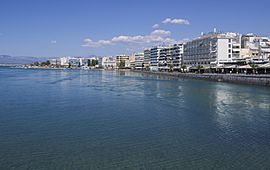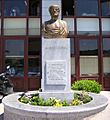Chalcis facts for kids
Quick facts for kids
Chalkida
Χαλκίδα
|
|
|---|---|

Chalcis' seafront
|
|
| Country | Greece |
| Administrative region | Central Greece |
| Regional unit | Euboea |
| Area | |
| • Municipality | 424.77 km2 (164.00 sq mi) |
| • Municipal unit | 30.80 km2 (11.89 sq mi) |
| Elevation | 10 m (30 ft) |
| Population
(2021)
|
|
| • Municipality | 109,256 |
| • Municipality density | 257.212/km2 (666.176/sq mi) |
| • Municipal unit | 64,490 |
| • Municipal unit density | 2,093.8/km2 (5,423.0/sq mi) |
| Demonym(s) | Chalcidian |
| Time zone | UTC+2 (EET) |
| • Summer (DST) | UTC+3 (EEST) |
| Postal code |
341 00
|
| Area code(s) | 22210 |
| Vehicle registration | ΧΑ |
| Website | www.dimoschalkideon.gr |
Chalcis (also called Chalkida or Halkida) is an important city in Greece. It is the main city on the island of Euboea (or Evia). Chalcis is located right on the Euripus Strait, which is a very narrow waterway.
The city's name comes from the Ancient Greek word chalkos, meaning "copper" or "bronze." Even though there are no mines there now, the name has stayed the same since ancient times. Later, in the Middle Ages, the city was known as Negropont(e). This Italian name was also sometimes used for the whole island of Euboea.
Contents
History
Ancient Times
The city of Chalcis is very old! It's even mentioned in the famous ancient Greek story, the Iliad. The story says that ships for the Trojan War gathered near Chalcis.
Around 800 to 700 BC, people from Chalcis became great explorers. They founded many new towns in other parts of Greece and in places like Sicily and southern Italy. These new towns helped spread Greek culture and trade. For example, the alphabet used by the people of Chalcis spread to Italy. The Etruscans used it, and later the Romans changed it into the Latin alphabet we know today!
Chalcis was once involved in a big war called the Lelantine War. This war was fought against another powerful city on Euboea, Eretria, over land. Chalcis won this war with help from its allies, becoming the most important city on the island.
Later, in the 6th century BC, Chalcis had a difficult war with the Athenians. After this, Chalcis joined important groups like the Delian League, which was a group of Greek city-states led by Athens.
Chalcis has also been home to a Jewish community for a very long time.
During the Hellenistic period, Chalcis became an important fortress. It was used by powerful kings to control central Greece. The famous philosopher Aristotle even spent his last year in Chalcis.
Under Roman rule, Chalcis continued to be a busy trading city.
Middle Ages and Modern Times
In the Byzantine era, Chalcis was often called Euripos, after the strait it sits on. It was an important city with a bridge connecting it to the mainland.
Around the 12th century, traders from Venice came to Chalcis. After the Fourth Crusade, Venice took control of the city in 1209. This is when it became widely known as Negropont or Negroponte. This name came from the Greek phrase "to Evripos," which sounded like "to Nevripos" and then became "Negroponte" in Italian.
The city was ruled by Venice and local lords. A large collection of old jewelry from Venetian times was found in Chalcis Castle and is now in the British Museum.
In 1470, the Ottoman Empire captured Chalcis after a long fight. The Ottomans made it an important naval base.
Chalcis became part of the new country of Greece after the Greek War of Independence. In the early 1900s, a railway connection to Athens helped the city's trade grow. The old part of the city, called the Castro, used to have strong defense walls, but these were removed for new buildings.
Today, Chalcis is a modern city with a railway station. There is also a Holocaust memorial to remember the Jewish people who lost their lives during World War II.
Main Sights
Saint Paraskevi Church
The Church of Saint Paraskevi is a very old and beautiful church in Chalcis. It was built around 1250 and is one of the oldest examples of early Dominican architecture still standing. It has amazing Italian Gothic stone carvings inside.
The Bridges
Chalcis is connected to mainland Greece by two bridges. One is the "Sliding Bridge" at the narrowest part of the Euripus Strait. The other is a newer, large suspension bridge called the Euripus Bridge, which opened in 1993.
The Euripus Strait is famous for a special natural event: its strong tidal currents change direction about every six hours! This creates powerful currents and whirlpools in the water.
Municipality
The city of Chalcis is part of a larger municipality (like a county) that includes several other areas. The municipality of Chalcis covers an area of about 424 square kilometers.
Transportation
Chalcis is connected by several national roads. There is also a railway station that connects the city to Athens.
Historical Population
| Year | Town population | Municipality population |
|---|---|---|
| 1981 | 44,847 | - |
| 1991 | 51,646 | - |
| 2001 | 53,584 | - |
| 2011 | 59,125 | 102,223 |
| 2021 | 64,490 | 109,256 |
Notable Residents
- Aristotle (384–322 BC), an ancient philosopher who lived in Chalcis for his last year.
- Eva Asderaki, a professional tennis umpire.
- Sotiria Bellou (1921–1997), a famous singer.
- Angelos Basinas (1976–present), a professional football player.
- Mordehai Frizis (1893–1940), a military officer.
- Orestis Makris (1898–1975), an actor.
- Georgios Papanikolaou (1883–1962), a physician who developed the Pap smear test.
- Nikos Skalkottas (1901–1949), a composer.
Sports Teams
Chalcis has several sports teams:
- NC Chalkida (water polo)
- Chalkida F.C. (football/soccer)
- AGE Chalkida BC (basketball)
| Club | Founded | Sports | Achievements |
|---|---|---|---|
| NO Chalkida | 1933 | Water Polo | Played in Greece's top league |
| Chalkida F.C. | 1967 | Football | Played in Greece's top league |
| AGE Chalkida BC | 1976 | Basketball | Played in Greece's second league |
Twin Towns
Chalcis is twinned with:
 Wuhan, China
Wuhan, China
Climate
Chalcis has a mediterranean climate. This means it has hot, dry summers and mild, rainy winters.
| Climate data for Chalcis | |||||||||||||
|---|---|---|---|---|---|---|---|---|---|---|---|---|---|
| Month | Jan | Feb | Mar | Apr | May | Jun | Jul | Aug | Sep | Oct | Nov | Dec | Year |
| Mean daily maximum °C (°F) | 12.9 (55.2) |
13.6 (56.5) |
16.0 (60.8) |
20.3 (68.5) |
25.3 (77.5) |
29.8 (85.6) |
32.6 (90.7) |
32.3 (90.1) |
28.9 (84.0) |
23.1 (73.6) |
18.6 (65.5) |
14.7 (58.5) |
22.3 (72.1) |
| Daily mean °C (°F) | 9.3 (48.7) |
9.8 (49.6) |
11.7 (53.1) |
15.5 (59.9) |
20.2 (68.4) |
24.6 (76.3) |
27.0 (80.6) |
26.6 (79.9) |
23.3 (73.9) |
18.3 (64.9) |
14.4 (57.9) |
11.1 (52.0) |
17.7 (63.9) |
| Mean daily minimum °C (°F) | 6.5 (43.7) |
6.9 (44.4) |
8.4 (47.1) |
11.6 (52.9) |
15.4 (59.7) |
20.1 (68.2) |
22.5 (72.5) |
22.3 (72.1) |
19.2 (66.6) |
14.9 (58.8) |
11.4 (52.5) |
8.3 (46.9) |
14.0 (57.2) |
| Average rainfall mm (inches) | 44.6 (1.76) |
48.3 (1.90) |
42.6 (1.68) |
28.2 (1.11) |
17.2 (0.68) |
9.7 (0.38) |
4.2 (0.17) |
4.6 (0.18) |
11.9 (0.47) |
47.7 (1.88) |
50.6 (1.99) |
66.6 (2.62) |
376.2 (14.82) |
| Average relative humidity (%) | 72 | 71 | 68 | 62 | 58 | 52 | 48 | 49 | 56 | 66 | 73 | 73 | 62 |
| Mean monthly sunshine hours | 137.9 | 144.5 | 187.5 | 238.9 | 303.3 | 341.2 | 373.7 | 356.5 | 283.4 | 218.5 | 164.3 | 136.4 | 2,886.1 |
| Source 1: www.yr.no | |||||||||||||
| Source 2: www.weather.gr | |||||||||||||
Images for kids
See also
 In Spanish: Calcis para niños
In Spanish: Calcis para niños


















